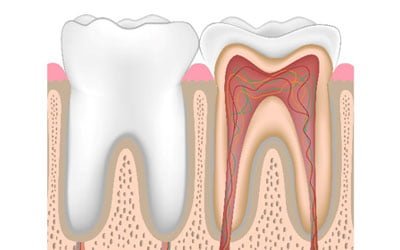What is endodontic treatment?
The word endodontic comes from two Greek words: “Endo” means inside, and “odont” means tooth. Therefore, endodontic treatment relates to the inside of the tooth.
It helps to understand the anatomy of teeth. The visible part of the tooth, also known as the crown, is made up of enamel. Beneath the enamel is a hard layer called dentin. Under this is the soft tissue called pulp. The pulp contains nerves, blood vessels, and connective tissue.
At Bright Smile Dental, the most common endodontic treatment Dr. de la Paz performs is root canal therapy.
What is root canal therapy?
The root canal itself is the pulp-filled cavity in the tooth root. While the pulp is required for tooth development, it is no longer needed once the tooth emerges. In fact, the only purpose it serves is to produce pain when the root canal is infected or inflamed.

Infection or inflammation of the pulp can be quite painful, and this is what typically sends someone to the dentist for treatment.
At this point, the only options are extraction of the tooth or root canal therapy. The goal of a root canal is to repair and save the tooth so that a dental implant or bridge is not required. A root canal removes the source of pain and allows for healing.
Root canal therapy is the process of removing the pulp and infected material and thoroughly cleaning the inside of the tooth. Next, the dentist carefully reshapes the canal, then fills it and seals the space.
How does pulp become inflamed or infected?
Many different things can inflame or infect the pulp. The most common cause is dental decay, also known as a cavity. While fillings can fix decay on the surface of the tooth, if the decay is severe and there is infection deep in the tooth, a filling will not fix the problem.
Other common culprits include a chip or crack in the tooth, a broken tooth, or repeated dental procedures on the tooth. Trauma can also cause pulp damage.
When the pulp is inflamed, damaged, or infected, blood flow increases to the area. This is what causes the pain, especially with biting, chewing, or ingesting cold or hot drinks or food.
If left untreated, pulp infection or inflammation increases, causing severe pain and sensitivity. It can also cause tenderness and swelling of the surrounding gums and discoloration of the tooth. Eventually, it can lead to an abscess.
It is important to note, however, that some patients experience no symptoms.
What is the process for root canal therapy?
The first step includes digital x-rays and a thorough examination by Dr. de la Paz.
If you need root canal therapy, Dr. de la Paz will discuss your options. He will then come up with a treatment plan that includes your input.
Before the procedure, Dr. de la Paz will completely numb the affected area. He will then place a “dental dam” over the tooth to keep it clean and protect it from saliva.
Next, he will make an opening in the crown of your tooth. Using tiny instruments, he will clean out the infected materials and pulp (including the nerves) from inside the tooth. He will then carefully reshape the root canals so that he can fill them properly with “gutta-percha.” This substance is biocompatible and protects the inside of the tooth and prevents recontamination. An adhesive cement keeps it in place.
Since the tooth root is removed, the tooth is considered “dead.” To protect your tooth from further damage and restore it to full function, a dental crown will be needed. Therefore, impressions are taken and sent to the lab.
Finally, Dr. de la Paz will close the opening with a temporary filling.
Once your dental crown is ready, you will need to return for removal of the temporary filling. Dr. de la Paz will cement the new crown in place. After restoration, the tooth will function like your natural teeth.
How much does root canal therapy hurt?
Since Dr. de la Paz uses local anesthesia, you should not experience pain during the procedure. Most likely, however, you will feel pressure and hear noises. If needed, nitrous oxide (laughing gas) can also be provided.
If you do experience pain, be sure to let us know so we can inject more local anesthesia.
After the procedure, you may experience pain and sensitivity for several days. Usually, however, these are less intense than the pain and sensitivity experienced before the root canal.
Over-the-counter medications are usually enough to relieve any discomfort, but some patients are given prescription pain medications.
It is best to consume soft foods and avoid extremes in temperature. You will also want to avoid chewing and biting with the affected tooth until after it is fully restored.
If You Are Experiencing Tooth or Jaw Pain, Sensitivity, or Swelling, Call us today at (253) 475-0262 Or Schedule An Appointment Online.

